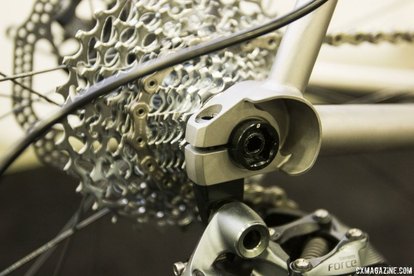What builders and brain surgeons should have in common Credit: CX magazine.com Credit: CX magazine.com The topic of this post has been keeping me up at night so I am going to get it off my chest. One of my upcoming builds is (of course) a disc-brake gravel bicycle (gravé, not pavé, no grinding here, just floating over the washboard like The Professor over cobbles). Everyone wants one. The data are clear that a disc brake bike should have thru-axles to control frame flex during braking; the rear thru-axle is essentially part of the frame (the front thru-axle is part of the fork). I designed custom rear thru-axle dropouts to accept the Syntace X-12 axle and a derailleur compatible with Shimano/SRAM road and SRAM cyclocross derailleurs. When I was at NAHBS 2015, one of the first bicycles to catch my attention was the Broken Arrow Cyclocross Bicycle by No22 Bicycles because it also uses a Syntace X-12 thru-axle. It was tricky to design a road hangar for the X-12 system, so I was eager to see No22’s take on the problem. However, I was disappointed: The Broken Arrow uses a standard X-12 hangar that was designed for a subset of mountain bike derailleurs, not the SRAM Force CX1 derailleur. At this point, you may have labelled me a obsessive quibbler, but being an obsessive quibbler is important in certain contexts: like brain surgery, flying an airliner, and framebuilding. The rest of this post is about:
Quibblers forever!
0 Comments
Bourbon, Beer & Beautiful Bikes | Wheels, Pieces and Parts I just returned from my second North America Handbuilt Bicycle Show in Louisville, Kentucky. NAHBS does a great job of showcasing custom bicycle builders and the companies that encourage and support them. If you’d like to know more about the show, check out the 2015 NAHBS website or online news coverage at Bikerumor, roadbikereview.com or Cyclocross Magazine. My wife Alexa went with me to keep me company and also on track (focus, Jamie). We had a great time at the show and experiencing a little bit of Louisville.
This post is as much for my own self-reflection as for your edification. I declined a prestigious fellowship and left a career as a neuroscience researcher to become a framebuilder and start Métier Vélo LLC. Why would I do this? There are a lot of reasons to leave a career in neuroscience research; the main two problems are 1) a glut of highly trained, qualified research scientists (with a Ph.D. and elite postdoctoral training) in the United States, and 2) chronic and severe underfunding of science and research in the U.S. (thanks, Congress). Clearly a bad combination. I won’t go into these problems here because they are boring and I can’t solve them.
The more interesting and relevant question is, why would I become a framebuilder? Here’s some items from the list I made when considering the career switch: |
AuthorJamie White Categories
All
Archives
November 2017
UpdatesSubscribeReceive update notices.
|

 RSS Feed
RSS Feed